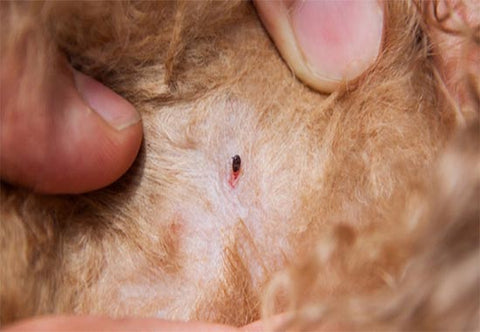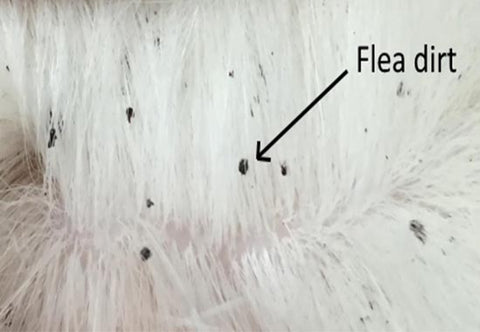The Natural Way to Flea Treatment for Dogs & Puppies
It's no surprise that fleas are one of the most dreaded aspects of summer for pet owners! Seeking safe flea treatments for dogs is so critical.
Fleas can live on your dog as well as in your surroundings. While fleas usually are more irritating in the spring and summer, in warmer locations like Australia, fleas can be active all year and are a common problem even for the most well-groomed dog.
We will do our best to provide you with a summary of the finest flea treatments for dogs. Stay with us!
Flea Treatment for Dogs - Know the Real Culprit
We will talk about flea treatments for dogs, but first and foremost, what are fleas?
Fleas are little, dark brown parasitic insects that live on pets' coats and skin. They may jump up to 150 times their length, making it difficult to keep fleas from spreading between your dogs. In addition, their exceptional jumping abilities enable them to transition from their surroundings to your pet swiftly.

Do you find it challenging to keep your pet flea-free? Don't worry; you're not alone in your quest to keep fleas under control. Fleas are prevalent during the summer months. They irritate and distress our pets. The key to keeping fleas away from your pet is prevention. Understanding more about fleas may assist you in developing the best flea treatment for dogs to augment your current plan.
Flea & Warm Treatment for Dogs - How to Identify
How can you tell if fleas are causing the itching, called pruritus, in veterinary terms? Unlike the burrowing, microscopic Demodex or Scabies Mites, fleas can be seen scurrying along the skin's surface.
Fleas are dark copper and roughly the size of a pinhead. Because fleas abhor light, your best bet for finding them on a dog is to examine within furry areas and on the belly and inner thighs.

"Flea dirt" can also indicate that a dog has fleas. Flea dirt appears as dark specks of pepper on the skin's surface. Pick some flea dirt off the pet and place it on a moist paper towel if you see it. Flea dirt is flea feces made up of digested blood. If the specks grow out like a small bloodstain after a few minutes, it's flea dirt, and your pet is infested with fleas.
Flea Treatment for Dogs - Think Before Choosing One
Remember that no two pets are alike. As a result, a product widely regarded as a safe flea treatment for dogs may be an excellent choice for one animal but a mistake for another. Consider the following factors:
Age: Flea treatments must be age-appropriate; many are not suitable for puppies under six months. This information can be found on the product's label.
Breed: The sort of coat you have may influence your decision. Thicker coats may make topical treatments challenging.
Health Condition: Other drugs or supplements you give your pet, concurrent health conditions, and previous reactions to flea and tick preventatives should be considered. For example, when large doses of ivermectin (heartworm prevention ingredient) are combined with spinosad (a flea preventative substance), dogs have observed neurologic issues.

Pet's Lifestyle: The presence of children and other pets (especially cats) in the family and your pet's regular activities/exposure to the outdoors are vital elements to consider.
Your area: What types of parasites are common in your area? Is there a risk of resistance to particular preventatives?
Your veterinarian will consider these factors and assist you in determining which flea and tick preventative are appropriate for your dog.
Many of the safest and most effective choices require a veterinarian's prescription, so it's best to have this conversation as soon as possible.
Natural Way to Flea & Worm Treatment for Dogs
Fleas not only irritate your dog and cause excessive scratching while inside your home, but they also deposit their eggs in your furniture, carpet, and anyplace else they may get into.
We encourage following your veterinarian's recommendations for flea treatment for dogs. Still, if you prefer a natural strategy, the good news is that there are many natural ways to cure fleas on dogs without using chemical treatments.
- You can use essential oils to cure fleas. Citronella, eucalyptus, peppermint, tea tree, and rosemary naturally repelled fleas. If your dog doesn't mind using a spray bottle, dilute a few drops of your preferred essential oil in 300ml-400ml of water and spritz directly onto your coat. It is critical to understand that certain essential oils, such as tea tree oil, can be extremely hazardous to dogs if not adequately diluted (.1 percent -1 percent ). Do not use a DIY essential oil solution on your pet until you have established its safety from a credible source and spoken with your veterinarian.

- The beauty of apple cider vinegar is that it is a natural way to cure fleas on dogs by balancing a dog's pH levels, generating an optimal environment for your dog's health while being unsustainable for fleas. Mix six cups of apple cider vinegar with four cups of water, add a dash of sea salt, and spritz directly onto your dog's coat. Avoid looking into your dog's eyes.

- This lemon bath is easy to prepare and will leave your pet feeling fresh. Mix half a cup of freshly squeezed lemon juice in two cups of water, then add a squeeze of your regular pet-friendly soap or shampoo. To cure fleas naturally, use this concoction in your dog's bath.
- Existing fleas will be killed naturally by any pet-friendly shampoo that produces a lather. Natural is always the best option for pet comfort, so choose an organic pet shampoo with no extra chemicals. After your dog has been adequately lathered, wait for a couple of minutes to perform its job. This is an excellent method for eliminating existing fleas before flea preventative medicines.
- A homemade flea collar is a clever approach to keep flea treatment for dogs consistent without having to spray or rub the mixture on them. Instead, purchase or construct a basic collar or bandanna, then dilute a few drops of lavender or cedar oil in water and apply to the collar or bandanna.

- Dunk your dog's comb or brush into fresh lemon juice and comb through their hair. A cloth dipped in lemon juice will provide the same advantage for a short-haired breed.
- Try dilating vinegar or apple cider vinegar in your dog's drinking water to attack and avoid fleas from the inside out. You'll need to test them first to ensure they like the flavor since you don't want them to stop drinking water altogether. Aim for one teaspoon of your preferred vinegar for every four glasses of drinking water. You will not only keep fleas at bay, but your dog's coat and skin will benefit as well.
Best Flea Treatment For Dogs - What About a Pregnant Dog?
Non Toxic flea treatments for pregnant dogs may be preferable. Many of the natural cure ingredients are readily available in your home. First, prepare a warm water bath for your dog and add around 1 cup of Dawn dish detergent. Soak her for approximately 5 minutes in soapy water. Then, using a flea comb, methodically search for the blood-sucking insects. Next, spray your pregnant dog with a mixture of apple cider vinegar and water after rinsing the soap off and towel-drying her. Finally, a few drops of rosemary oil can be added to your dog's collar.

Adding apple cider vinegar or extra-virgin coconut oil to your dog's diet is another common home remedy. After removing the fleas from your pregnant dog, you'll need to ensure that her surroundings — furniture, dog bedding, and carpet — are similarly insect-free. All bedding should be washed in hot water. And then sprinkle the boric acid powder all over your carpet, fabric furnishings, let it sit for a few hours, and vacuum it up. Rosemary, lavender, and mint are natural flea repellents, so plant them in your garden or around your home.
Flea And Worm Treatment For Dogs - Do Not Use These Options
It might be unpleasant to watch your dog suffer from flea infestation. However, before you rush out to locate a remedy, there are some flea treatments for dogs that can be dangerous.
Oral flea and tick preventatives are the most severe violators and the most harmful to use on your dog. Unfortunately, they are frequently given to your dog as a pleasant chew. Isoxazolines are found in these medicines. They're also usually available with a doctor's prescription.

Isoxazolines are a class of chemicals found in several of these medications. They are GABA (gamma-aminobutyric acid) receptor antagonists that are non-competitive. This implies they bind to chloride channels on the flea or tick surface. In layman's terms, they disrupt nerve signals, causing the bugs to become paralyzed and die. The issue with poisoning fleas and ticks is that you will also poison the host... your dog!
Owners of dogs have experienced several significant adverse effects. Seizures are a typical example. In addition, these medicines can cause the following side effects:
- Tremors
- Seizures
- Ataxia – stumbling, falling, incoordination
- Vomiting
- Diarrhea
- Loss of appetite
- Skin irritations
- Lethargy
The second most dangerous category is impregnated flea and tick collars, which your dog wears all day and night for up to 8 months. So they're always there under your dog's nose. Chemicals are absorbed through the skin. And, unlike oral flea and tick preventives, your dog should not consume these. However, mishaps do occur.
These collars contain neurotoxins, endocrine disruptors, and immunosuppressants. They are capable of causing the following signs and symptoms:
- Nausea, vomiting
- Seizures
- Diarrhea
- Salivation
- Tremors and Convulsions
- Hyperactivity and hypersensitivity to touch or sound
- Inflammation
- Kidney and liver damage
- Organ toxicity
Because flea and tick prevention is a large business, it's no surprise that counterfeit treatments are fighting for a piece of the pie. So be careful of fake collars.
Flea Treatment For Dogs - Prevention is Better Than Cure
Though there are many flea treatments for dogs available, it is always better to prevent any disease.
Dogs and cats are particularly vulnerable to fleas, but they can be prevented. To keep fleas away from your pet, do the following:
- Shorten the time your pet stays outside.
- Limit your interactions with wild and stray animals.
- Pets should be bathed and brushed regularly.
- Regularly check for fleas.
It's easier to keep fleas away than getting rid of them. Fleas can live in carpets, bedding, and other surfaces in the home frequented by dogs. To avoid an infestation:
- Sweep or vacuum thoroughly and frequently—vacuum carpets and rugs and chair and sofa cushions. When finished, make sure to empty the vacuum bag outside.
- Clean beds, especially pet bedding, using soap and water regularly.
Fleas prefer shaded settings since they cannot survive the sun for lengthy periods. To avoid flea infestations, make your yard as unappealing to fleas as possible by doing the following:
- Frequently mow the lawn. Mowing opens the soil to sunlight, which fleas shun.
- Overwatering should be avoided. Because fleas flourish in humid surroundings, keeping the yard dry makes it less appealing.
- Insecticides are used in dog runs to make them less susceptible to fleas.
- Thoroughly rake to eliminate any material. This exposes fleas to potential insecticides and eliminates shaded and damp breeding areas.
Final Words
We do not want our dogs to suffer in any way. However, things can go awry. Seeking the best flea treatments for dogs is one of the ways we can provide the best care for them. We understand your apprehension. That's why we compiled a list of every potential flea treatment method. But it is always wise to discuss with your veterinarian. Do not use any chemical medication without first talking with your vet. It can be harmful to your dog, perhaps lethal. So make an informed decision.







